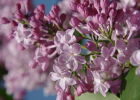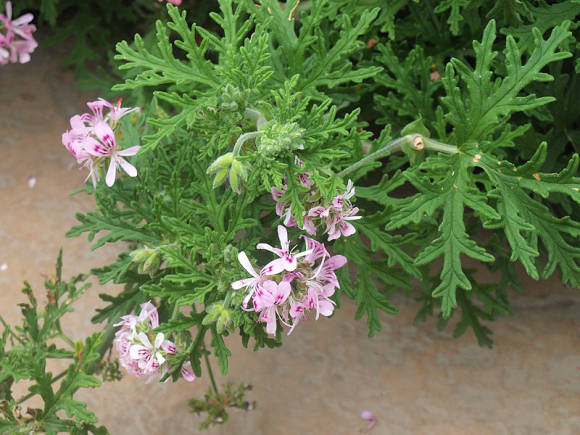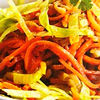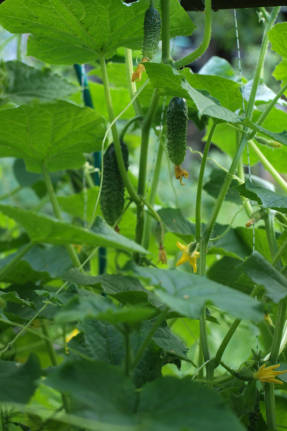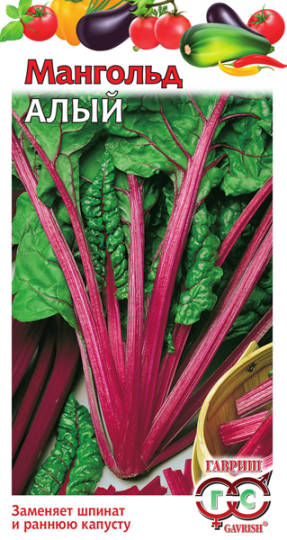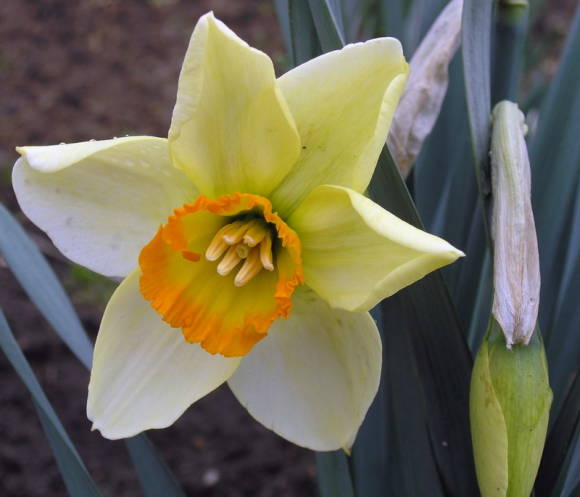During off-season, onions can be “driven out” on the windowsill, they will make your winter menu more varied and nutritious.
 |  |
Site selection, soil... Onions grow best on loose, fertile soils. Their thin roots struggle to make their way inside heavy clay soils, and on poor soils, plants simply starve. Therefore, if the land on your site leaves much to be desired, before planting onions, you need to add a lot of compost (at least 10 kg / m2) and deeply and thoroughly loosen the bed under the onions with a garden pitchfork. A complete mineral fertilizer with trace elements is also introduced in accordance with the agrochemical characteristics of the soil.
Landing... Planting material for onions is shallots, cuttings of bushes of perennial species, bulbs and, of course, seedlings (seedlings). Perennial onions can be divided and replanted in spring and early fall.

Growing seedlings... Seeds for seedlings are sown in protected ground 8-10 weeks before planting in open ground, or in a nursery in open ground as early as possible. In most regions of Russia, it is recommended to plant onion seedlings in spring three weeks before the date of the latest frost (based on average annual meteorological indicators).
Sowing is carried out in boxes with a nutritious soil mixture for seedlings, which are placed on a windowsill in a ventilated room. The soil mixture is constantly kept moist. Seedlings can be transplanted into open ground when they reach half the length of a standard pencil, but it is more convenient to plant larger seedlings, so do not rush to plant, you need to prepare the garden well. Seedlings are planted in grooves 12-16 cm deep, with a distance between plants in a row of 10-15 cm. The seedlings are slightly spud.
Care... During the first 45 days after planting, the bed of onions will have to be weeded 2-3 times. Onions take root slowly, and during this period they cannot compete with fast-growing weeds. You can mulch the surface of the ridges with a thin layer of peat, wood chips or chopped straw, and there will be less weed problems. In addition, mulch helps to preserve soil moisture, but in this case it will be necessary to increase the dose of nitrogen fertilizers.
At the beginning of the growing season of onions, the soil should be constantly kept moist, frequent watering in small doses is preferred. Sudden changes in soil moisture can cause chlorosis and leaf necrosis. It is recommended to feed the plants once every two weeks, preferably with a solution of mineral fertilizers or mullein infusion.
Leek (Allium ampeloprasum var.porrum) stands out in the garden with a regal bearing. Important advantages of this species are simple agricultural technology and resistance to pests and diseases. Leek is used to prepare excellent soups, dietary vegetable dishes and gourmet delicacies. "Legs" are cut into rings and fried in butter or olive oil. It is a great addition to stews, soups, pie filling. Tender young leeks can be deep-fried or grilled.
Leek products are well stored in the refrigerator in perforated plastic bags for 2-3 months.
Leek is a crop with a long growing season (more than 130 days), therefore, in the temperate climate zone, it is grown mainly from seedlings. There are a lot of varieties, they differ in early maturity, leaf color, length and diameter of the leg. Plants are edible at any stage of development, so they can be harvested as needed (younger plants are more tender and tasty).
 |  |
Before planting leek seedlings, the tops of the leaves and the tips of the roots are cut by 1.5-2 cm from the seedlings in order to stimulate growth processes. To obtain high-quality products with bleached false stems, each plant is sprinkled on all sides or covered with mulching material, as if it had sprouted through loose soil. This technique is called whitening. Plants are drawn to the sun, the length of the "leg" increases, and the etiolated bases of the leaves, which form a false stem, are more tender.
The flavoring qualities of winter varieties increase when harvested in late autumn or even after overwintering. In recent years, there has been a long warm autumn in central Russia and leeks can be harvested almost until December - the value of this lively, vitamin-rich product cannot be underestimated. Extend the harvest season for cold-resistant leeks by covering the plants with 6-8 cm of straw before the first hard frost. Just do not forget that if the air temperature drops below + 10 ° C, the plants may freeze, and it will be problematic to remove them.
After harvesting the leek, cut the roots and tops of the leaves so that about 5 cm remains above the bleached part. This can be done right in the garden, leaving the cut leaves and roots in the compost heap. In the spring, the leek will need to be removed before the arrows appear inside the false stem, since with the development of the peduncle, the bases of the leaves become thinner and coarser.

Shallot (Allium sulfur Aggregatum Group) is versatile in culinary use, it is added to stews, fried, grilled dishes, dried and frozen. It is the shallot that gives the extraordinary taste to aspic. It is softer than onions and goes better with other foods.
Modern shallots can be grown not only from bulbs, but also from seeds through seedlings. The easiest way is to plant small bulbs in a loose, fertile bed in early spring. Keep in mind that in organic and nutrient-rich soils (especially nitrogen), plants will grow larger, with beautiful, intensely green leaves, but the aroma will be weaker. The tops of the bulbs during planting remain at the level of the surface of the ridge, which must be mulched. Bulb nests will form during the summer. In the southern regions, vegetable growers can plant shallots before winter for harvesting next summer.
Currently, there are varieties of the French type - Matador and Ambitionwhich grow quickly and form nests of 5-8 rounded, rather large bulbs.
Remove the shallots when the leaves are 3/4 dry. Dry the bulbs in a well-ventilated area until the necks are dry and thin. Shallots are well stored in a cold (below + 5 ° C) dry place.
Multi-tiered bow (Allium cepa Proliferum Group). In other countries, it is called the Egyptian or walking bow. Several tiers of small onions - bulbs are formed on the stem. The height of the arrow to the first tier is 60-80 cm, the largest bulbs are formed on it, up to 2 cm in diameter.They germinate immediately, and the leaves reach a length of 10-15 cm.Under the weight of the bulbs, the stems fall to the ground, and the bulbs are able to take root at a distance from the mother bulb, this is how this onion settles. Having planted a multi-tiered bow, you can observe this in your garden. The underground bulbs are large, form nests and are very similar to onions, but do not ripen and are poorly stored. The leaves are dark green, fistulous, 30-35 cm long, about 1 cm in diameter. They are very tender, juicy and tasty, for which the multi-tiered onion is valued.
 |  |
Plant tiered onions in the fall, cut the leaves in the spring, and remove the bulbs when the leaves begin to dry out - from mid-summer to fall. For planting, you can use freshly harvested bulbs, but you can let the bulbs take root and grow, and then transplant them with a lump of earth to a new place.
If the bulbs need to be stored, they are well dried without separating them, and stored in dry, unheated rooms, where there are no sudden temperature fluctuations.
In the first year after planting the bulbs of the 1st tier, large bulbs grow, with a diameter of 3 to 7 cm, in the second year they intensively divide, forming a nest of smaller bulbs, which also divide the next year.
With good plant care during the season, you can get 3-4 harvests of excellent greenery. Multi-tiered onions are successfully used for forcing in protected ground, they are less demanding on lighting conditions than onions, have practically no dormancy period and grow quickly. The duration of forcing, depending on conditions, is 25-40 days. Many amateur vegetable growers grow multi-tiered onions in autumn and winter on a windowsill in containers (30x15x12 cm) from both bulbs and small underground bulbs.
Perennial bows
Most types of onions are grown for greens in an annual or biennial crop, but many species have proven themselves better as perennials, consistently yielding leaves from year to year with minimal maintenance.
Early spring, when nothing has yet grown in the garden, is the crown time for perennial onions. It is necessary to collect leaves of different types, cut finely and finely - the smaller, the better the nutrients are absorbed - and add to soups, salads, sprinkle garnishes on top. In very small quantities, they bring tremendous benefits to our body, which really needs vitamins and sunlight after a long winter. Flowers can be used to decorate dishes and as a savory seasoning.
When grown in a perennial culture, onion leaves begin to be cut from the second year of life, as they grow back. Cut the leaves when they are young and juicy, it is at this time that they contain the most biologically active substances and mineral salts.
You can plant cuttings of these onions or grow seedlings. New varieties are usually grown from seed.
With intensive cutting, planting of perennial onions is used for 3-4 years (only 5-6 years of life), then it is better to update the plantation. Plant care should ensure successful overwintering, harmonious regrowth and rapid growth of leaves. In the spring, the area should be cleaned of plant debris and deeply loosened. During the period of leaf regrowth, a complete mineral fertilizer with microelements is applied, calculated for soils with an average supply of nitrogen, phosphorus and potassium according to the active ingredient N60P40K80. At the end of summer, fertilizing with phosphorus and potash fertilizers is carried out so that the plants are well prepared for winter.
Batun onion (Allium fistulosum L.) is traditionally used in Chinese and Japanese cuisine. In our country, it is also found in any garden called winter onions.
Batun is most often propagated by dividing the bush - the bush is dug up, cut with a sharp knife into pieces with several bulbs and transplanted. You can, without digging a bush, carefully separate the lateral shoots from its outer side and plant them in a new place. Trampoline can be grown for greens from seeds that are sown in spring or summer right in the garden. Approximately 2.5 months after the emergence of seedlings, the plants will reach commercial size (height at least 25 cm), and they can be harvested on a bunch with roots, thus thinning the crops. Keep in mind that the leaves begin to coarse quickly.
 |  |
In the second year of life, usually 2 months after the spring regrowth, peduncles are formed, however, young arrows are quite gentle, and they can be cut into salads together with the leaves. The batun blooms in mid-June, the seeds ripen in July.At the end of summer, a second wave of leaf growth begins; in some years, secondary flowering of plants occurs, although not as abundant as in spring.

Schnitt bow (Аlium schoenoprasum L.) with thin dark green leaves and a strong onion aroma is grown as a vegetable, ornamental, medicinal and melliferous plant. It is not picky about growing conditions and is easy to culture. The bush is very dense, reminiscent of the sod of cereals.
In terms of the amount and composition of vitamins, chives are one of the most valuable vegetable onions. It is indispensable for the northern regions, where the range of vegetable crops is limited.
The leaves are small, delicate, fragrant; are used as a seasoning for soups, meat, fish and vegetable dishes, to increase the vitamin value, digestibility of food, as well as to decorate dishes. This is a crop for year-round production of greens, since the plants do not have a period of deep dormancy; they can be grown in autumn and winter. Fast growing chives are the most suitable type of onion for the salad lines of modern greenhouse complexes.
Chives grows quickly in early spring, branches strongly and gives a large green mass, which can be cut off as early as 2.5-3 weeks after the start of the growing season. The cutting period is short as the leaves coarsen quickly.
Blooming chives are very decorative due to the abundance of bright green subulate leaves and oval inflorescences, the color of which ranges from white to silvery pink and reddish purple. Very effective when planted in large clumps. When dried, the flowers become pinkish-pearl and are used for winter bouquets. After the seeds ripen at the end of summer, a second wave of leaf growth is observed.
Schnitt is widely used in Western Europe as a seasonal potted plant. For a pot culture, seeds are sown thickened, in wide strips, in fertile soil (it is possible in a 10-15 cm thick substrate layer in a pallet or on an underlying film). A dense sod forms after a year. In the fall, it is dug in, cutting the roots at a depth of about 10 cm, then cut into small blocks, transplanted into pots and used for room culture for cutting.
Chives are usually not transplanted for 4-6 years, but no more, since later the sod becomes very dense, the plants oppress each other and the yield decreases.
Slime onion, or drooping (Allium nutans L.) is valued as a food, medicinal, ornamental and melliferous plant. Its leaves are tender, juicy, do not coarse for a long time, mucus is abundantly secreted on the cuts. They contain mineral salts important for the human body, this onion is especially rich in iron and therefore is useful for anemia.

Slug onion is a relatively unpretentious perennial winter-hardy plant with a high adaptive ability. Young leaves grow constantly, practically throughout the year, with a forced break in winter and maximum growth in spring and early summer. In the spring (immediately after the snow melts), last year's leaves first start to grow, and only then new ones appear. A valuable property is that the leaves do not coarse and retain high taste during almost the entire growing season. In central Russia, slug onion blooms in the second half of July. The seeds ripen in late August - early September.
The slime has a powerful horizontal rhizome 1.5-2.0 cm thick with a pronounced age-related dissection. On the 6-7th year of life, the number of renewal shoots decreases and, due to the death of rhizome areas, the plant is divided into several daughter individuals.
Slime onions reproduce well by seeds and vegetatively. Planting with annual seedlings has advantages over dividing the bush. It is less labor intensive and the plants are more productive. It is better to start cutting leaves from the age of 3. They are cut at a length of at least 25 cm. During the summer, you can carry out 3 cuts, the last one - no later than the beginning of August, since the plants need to get stronger by the onset of cold weather.Cutting enhances branching and accelerates the aging process of plants. A leaf can be cut off constantly, as needed.
Fragrant onion, or branched (Allium odorum syn. A. ramosum, A. tuberosum) Is a popular green culture in Japan, China. It has narrow, flat, dark green leaves with a pleasant taste and slightly chalky aroma, as well as fragrant snow-white flowers. Fragrant onions are mainly used fresh, since up to 80% of vitamin C is lost during processing, but it can be added to canned food and even salted for the winter.
 |  |
This is a thermophilic, relatively drought-resistant plant, which at the same time tolerates frosts down to –45 ° C in winter even with a small snow cover. In spring, sweet onions grow much later than other types of onions. The optimum temperature for the development of sweet onion plants is + 20 ° C, but it grows normally at lower temperatures in the temperate zone.
Flowering begins after the spring-summer wave of leaf growth, usually in July, and lasts until the onset of cold weather - new flower stalks appear one after another. Fragrant onion is an excellent honey plant, and the honey obtained from it does not have an onion smell. During flowering, bees and butterflies flock to the umbrellas of sweet onions.
Propagated by seeds and dividing the bush. The rhizome (outwardly similar to the rhizome of a bearded iris) branches quite strongly, forming dense clumps. Thick roots extend from the bottom of the rhizome and penetrate deeply into the soil. The seeds are large (1000 pcs. Up to 4.5 g), wrinkled, with a shiny surface.
In the first year of life, when grown from seeds, allspice grows slowly. The process of formation and growth of leaves continues from spring to autumn, a new leaf appears every 8-10 days. Therefore, it is usually sown first in a small bed (nursery), and then transplanted to a permanent place.
Fragrant onion leaves are very juicy and lose their freshness rather quickly, they can be stored in the refrigerator for no more than 2-3 days.
Uncommon perennial bows
There are a lot of such species, but decorative species prevail among cultivated ones, we recommend two (or rather three) wonderful types of onions for universal use.

Oblique onion (Allium obliquum L.) occurs naturally in the mountain ranges of Central Asia, in the south of Siberia, in the Urals, as well as in the Carpathians and Tatras. Botanists consider it a relict plant that appeared in the preglacial period.
Oblique onions deserve to be planted in a garden plot, 1-1.5 m2 of loose fertile land is enough for it. In spring, slanting onions grow earlier than other onions, immediately after the snow melts, supplying unique vitamin greens containing up to 160 mg% of vitamin C! This vegetable, ornamental and medicinal plant adapts well when introduced in new environmental conditions and is successfully cultivated. In southern Siberia and Altai, the local population collects scythe onions in nature and grows them in vegetable gardens. Early greens are eaten, as well as onions, which are mainly used for pickling or as spices for canning.
The bulbs are oval-conical, 4-6 cm high and 1.5-2.5 cm in diameter, attached to a short rhizome. The outer dry scales are dense, scarious, their color varies from pinkish-yellow to brownish. Perennial roots, relatively thick, weakly branching. On the shoot, depending on age, 3-8 flat, linear, tapering to the top, folded along the central vein of the leaves are formed.
Oblique onion is an early ripening species: the duration of the growing season (from regrowth of leaves in spring to maturation of seeds) is 100-115 days. When grown from seeds, slanting onion plants turn to flowering in the 3rd year of life (single specimens in the 2nd year). Leaves grow intensively from spring to mid-June, then gradually begin to die off. Blooms in late June for 8-12 days. The seeds ripen in early August.

Onions are propagated by slanting seeds and dividing bushes, however, the coefficient of vegetative reproduction is low, therefore seed reproduction prevails. Seeds are sown before winter, since the germination rate is much lower during spring sowing. In the first year, the plants are grown in a nursery on a small area, then transplanted to a permanent place. When propagating by dividing the bush, the transplant of daughter bulbs is carried out in September. The bulbs are planted, deepening them to 2-3 heights. Sunny dry areas are preferred. Plants are watered only in dry seasons.
Oblique onions are decorative and a good honey plant. Fluffy golden inflorescences-balls are suitable for bouquets. Umbrellas cut at the beginning of flowering stand in the water for about two weeks.
Ramson
Under the popular name "wild garlic", two close botanical species are combined: victory onion and bear onion. The value of wild garlic as a food, vitamin, medicinal and spice plant is widely known. Young shoots are eaten fresh, salted, pickled, pickled and dried.
Victory bow (Allium victorialis L.). Truncated-conical bulbs, 1-2 cm in diameter with reticulated brown shells, are attached to a developed rhizome. The leaf blade is green, broadly elliptic, 2-8 cm wide, extending from the petiole, which is 2-4 times shorter than it. Peduncle 30-60 cm high is dressed in leaf sheaths by one third. The inflorescence is a spherical multi-flowered umbrella. The flowers are whitish green or yellowish. Blooms in early June. The fruit is a spherical-triangular capsule.
 |  |
Bear onion (Allium ursinum L.). Elongated oval bulbs with a diameter of about 1 cm with fibrous brown shells are attached to a developed rhizome. The leaf blade is bright green, oblong-elliptical, 3-5 cm wide, with a pointed end. The petiole is equal to or 2 times shorter than the blade. The peduncle is 15-40 cm high, the inflorescence is a bundle or hemispherical umbrella. The flowers are white. Blooms in late May - early June. The fruit is a spherical-triangular box.
Seeds in both species are round, black, with a dense, shiny shell. They germinate only with podzimny sowing or after stratification for 80-100 days (temperature 0 + 3 ° C). Seeds stored at room temperature and sown in the spring will only germinate in the spring of next year.
Nutritional value, specific taste, vitamin properties of greens and unpretentiousness of plants make victorious and bear onions promising for introduction into culture. For them, shaded areas with loose and sufficiently fertile soil are chosen. The land under trees and large shrubs is usually empty or overgrown with ordinary depressions. Ramson is an ideal plant for such places, since it grows in early April, when the trees are not yet covered with foliage, and by mid-July the aboveground part of the plants dies off.
Rhizomes and bulbs of wild garlic are located at a depth of 15-20 cm, so only loose, well-aerated, organic-rich soil is suitable for it. Plants are hygrophilous and require watering during dry periods. Ramson is sensitive to grasses, wheatgrass is especially dangerous: its rhizomes with sharp ends, growing, pierce the bulbs.
Once you've planted all of these onions in your garden, you will definitely want to try out new recipes with them. Here's an inspirational recipe we read in Organic Gardening magazine - try this:
Chop freshly picked leeks and shallots, heat some olive oil in a skillet and sauté the onions over low heat. When the kitchen is filled with delicious aroma, go to the vegetable garden, see what you can collect, add this to the fried onions and bring the dish to readiness. Success is assured.
